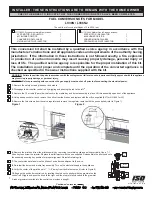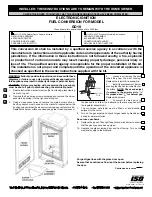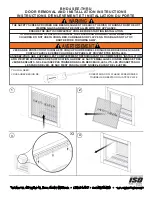
22
W415-0612 / C / 01.25.08
REAR VENT
TOP VENT
13
1
/
4
”
22
1
/
4
”
22
1
/
4
”
2
"
4
"
4
"
6
"
2
"
SIDE
WALL
PROTRUSION
INSIDE
CHASE
OUTSIDE
CHASE
13
1
/
4
”
22
1
/
4
”
22
1
/
4
”
22
1
/
4
”
33
1
/
2
”
23”
MINIMUM
22
1
/
4
”
4
3
/
4
”
2
1
/
2
”
HEADE
R
MINIMUM
53
1
/
8
”
ENCLOSURE
HEIGHT
13
1
/
4
”
34
3
/
8
”
2
"
4
"
4
"
6
"
2
"
PROTRUSION
SIDE
WALL
INSIDE
CHASE
OUTSIDE
CHASE
FIGURE 37
FIGURES 38 a&b
FIGURE 39
FIGURES 40 a,b&c
22
1
/
4
”
4
3
/
4
”
2
1
/
2
”
HEADER
MINIMUM
39
1
/
8
”
ENCLOSURE
HEIGHT
13
1
/
4
”
34
3
/
8
”
* HORIZONTAL VENT SECTIONS - A minimum clearance of 1" at the bottom and sides and 2" at the top of the vent pipe in all horizontal
runs to combustibles is required. Use
fi
restop spacer W010-1774 (supplied).
* VERTICAL VENT SECTIONS - A minimum of 1" all around the vent pipe on all vertical runs to combustibles is required except for clearances
in
fi
replace enclosures. See "Minimum Enclosure Clearances" section. Use
fi
restop spacer W500-0096 (not supplied).
Minimum clearance to combustible construction from
fi
replace and vent surfaces:
Combustible Framing:
-
0" to stand-offs
-
1" to bottom and sides of the vent pipe*
-
2" to top of the vent pipe*
Combustible Finishing:
-
0" to rear
-
0" to front face top and sides
-
13" recessed depth
Rear
Vent
-
39 1/8" to enclosure top from base of the unit
-
45 1/8" to ceiling from base of the unit
Top
Vent
-
53 1/8" to enclosure top from base of the unit
-
53 1/8" to ceiling from base of the unit
FRAMING
It is best to frame your
fi
replace after it is positioned and the vent
system is installed. Frame to local building codes.
NOTE:
In order to avoid the possibility of exposed insulation
or vapour barrier coming in contact with the
fi
replace body, it is
required that the walls of the
fi
replace enclosure be “
fi
nished” (ie:
drywall/sheetrock), as you would
fi
nish any other outside wall of a
home. This will ensure that clearance to combustibles is maintained
within the cavity.
To install the
fi
replace face
fl
ush with the
fi
nished wall, position the
framework to accommodate the thickness of the
fi
nished wall.
It is not necessary to install a hearth extension with this
fi
replace
system.
When roughing in the
fi
replace, raise the
fi
replace to accommodate
for the thickness of the
fi
nished
fl
oor materials, i.e. tile, carpeting,
hard wood, which if not planned for will interfere with the opening
of the lower access door and the installation of many decorative
fl
ashing accessories.















































